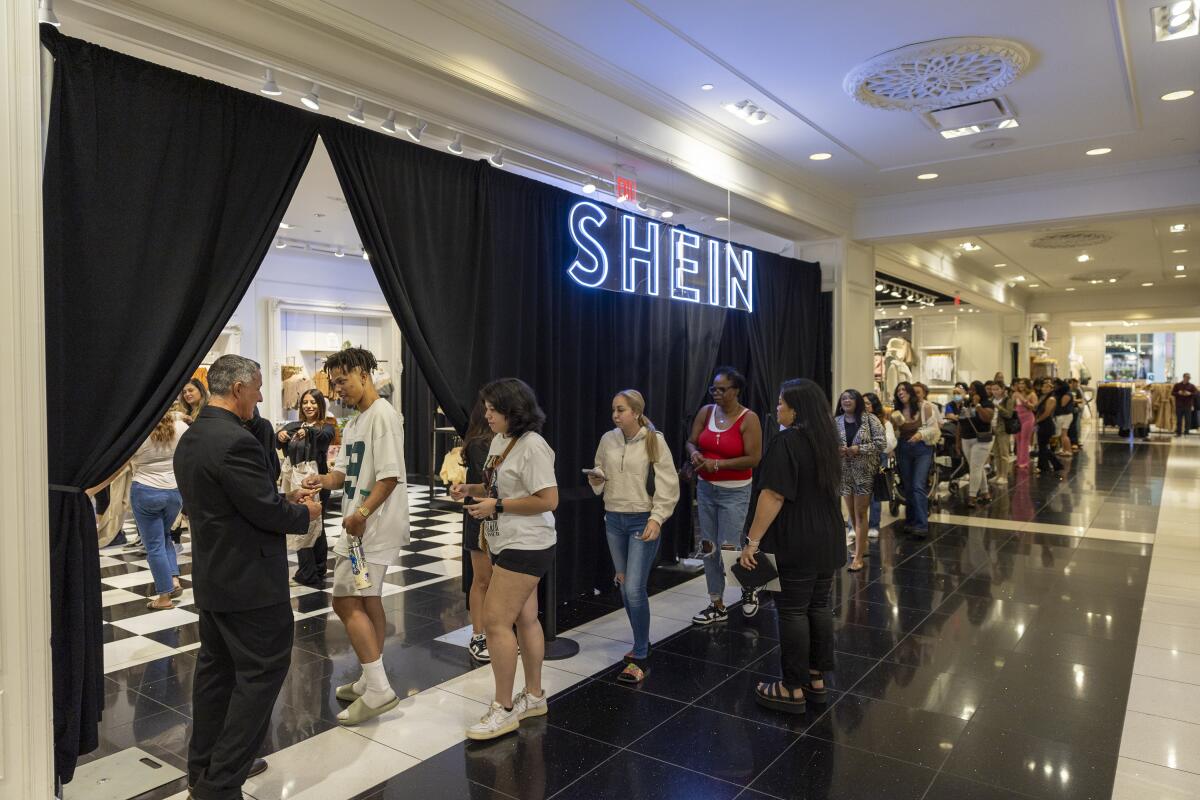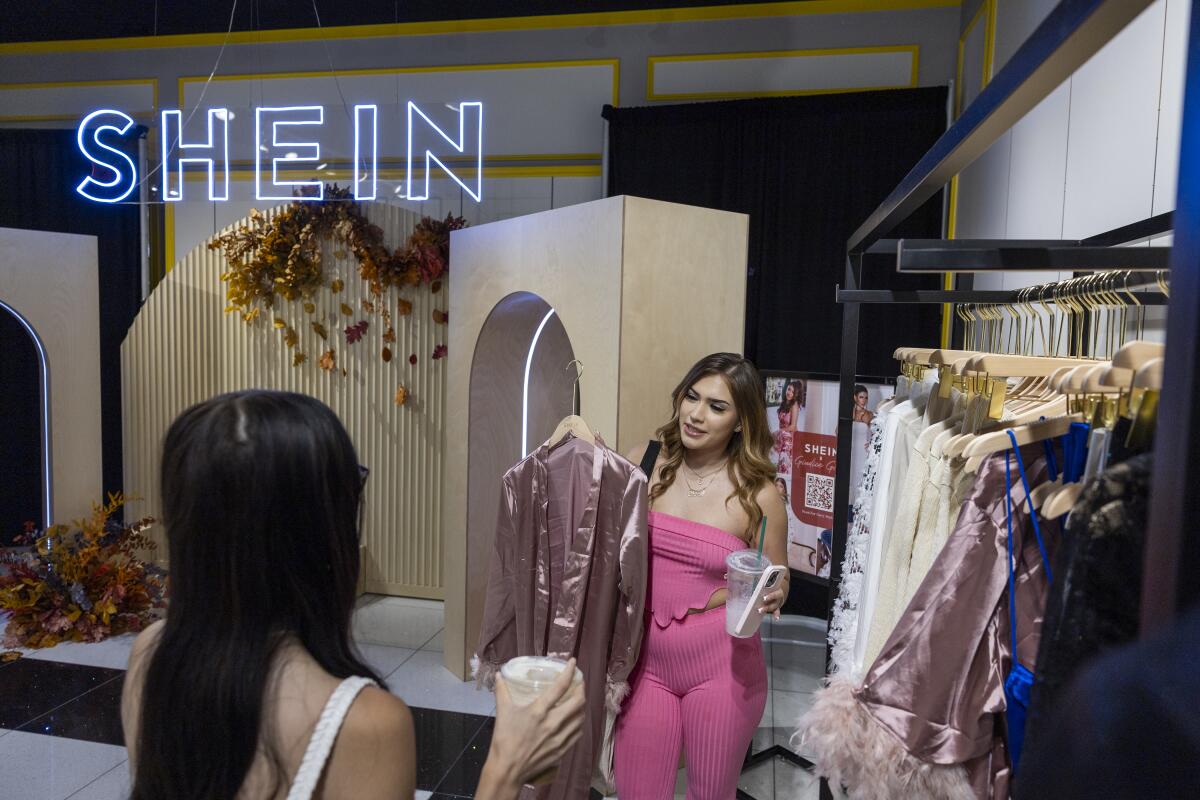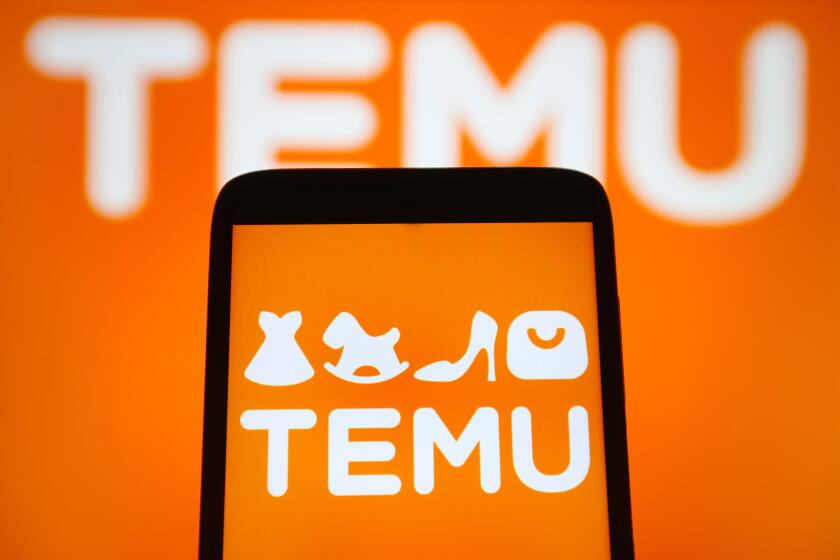Shein launches its first offline pop-up — inside one of its biggest rivals

- Share via
At 10 a.m. Thursday, dozens of shoppers were already lined up outside the Forever 21 store at the Ontario Mills mall. Most were patiently waiting to shop a brand rarely seen in 3-D. And it wasn’t Forever 21.
The doors were about to open for Day One of a four-day pop-up for e-commerce giant Shein. A section of Forever 21’s permanent storefront had been transformed into a shop for apparel, beauty products and accessories sold by the online-only Chinese-founded retailer, complete with its own employees and checkout counter.
The event drew a mixed crowd, including teens with curled hair and full glam makeup and mothers pushing children in strollers. One woman, a government employee, said she had called in sick to make it to the pop-up.
When the doors opened, the stream of shoppers beelined toward a neon Shein sign hanging above black curtains that subtly divided the pop-up from the rest of the 50,000-square-foot store. Some took out their phones to film the crowd as a DJ Khaled song thumped in the background.
Although Shein and Forever 21 may seem more like competitors than collaborators — both fast-fashion brands have made names for themselves selling trendy, inexpensive apparel, mostly for women — they began a partnership in August. The goal is to leverage each of their business strengths to remain competitive in the notoriously tough apparel market.
Any stigma of buying fashion secondhand is gone. Shoppers are running mini resale businesses as the investment value of certain luxury brands has soared.
For Forever 21, it’s a chance to tap into Shein’s online customer base. And for Shein, the collaboration offers access to Forever 21’s footprint at malls across the U.S., where it has more than 400 stores. The Ontario Mills event is the first Shein pop-up inside a Forever 21.
“There was a brief moment in the pandemic, while stores were shuttered and online commerce was soaring, when retailers started to wonder what kind of role the physical store still had to play,” Jill Standish, global retail lead at consulting firm Accenture, wrote in a Forbes column in April.
“Three years on, and we can say definitively that stores remain absolutely key to the retail industry’s future.”
But the strategies behind running a successful bricks-and-mortar store are shifting, Standish said. “Retailers need to be willing to reset their store strategies — and do so as part of a broader reinvention of the business — if they want to truly capitalize on the growth opportunities.”
In August, Shein acquired about a third of the shares of Sparc Group, which operates Forever 21, and Sparc Group became a minority shareholder in Shein. Sparc Group is a joint venture between shopping mall operator Simon Property Group, which runs Ontario Mills, and Authentic Brands Group. Sparc Group’s other brands include Brooks Brothers, Lucky Brand and Eddie Bauer.
Shoppers are looking beyond just the price tag of a skirt or a pair of pants in the wake of still stubbornly high inflation.
Now, Forever 21’s stores can host pop-ups for Shein, where customers can try things on and touch the fabrics before they buy — and peruse the racks of Forever 21 apparel afterward.
“There’s an experimental phase going on right now with retail, particularly malls,” said Kevin Fagan, head of commercial real estate economic analysis at Moody’s Analytics. “So this is kind of part and parcel with that trend.”
Successful malls used to be built around department stores, which attracted other tenants that wanted to set up shop in the same complex. Today, malls need more demand drivers to keep afloat — food courts, temporary pop-ups, gyms, and other offerings, Fagan said.
“These malls are becoming something very different than what they used to be,” Fagan said. “The old mall was a very simplistic business model.”

Ashley Sanchez, 18, and her friend Joscelin Flores, 19, both dressed in mostly Shein apparel, arrived at Ontario Mills for the pop-up about an hour before the doors opened, just to be safe. When asked what they shop for at Shein, the answer, for Flores, was simple: everything.
Sanchez said she favors Shein for everyday clothes. “They do have good basics, but it sucks that I can’t feel the material,” she said. “That’s why I wanted to come — to see the materials in real life.”
The pop-up occupies 8,000 square feet of Forever 21’s space and has sections for women’s, men’s and children’s clothing, along with beauty products. An Instagram photo-op backdrop was bedecked in faux fall foliage and another neon “Shein” sign. Customers frantically flipped through the racks of clothes, putting pieces that caught their attention into canvas totes handed out by employees.
Products made in China’s western province of Xinjiang are being sold to American consumers through the online shopping platform Temu, in breach of a U.S. ban that forbids goods from the region due to links to forced labor.
Despite the success of digital-first brands, bricks-and-mortar stores still have the advantages of a tactile experience and a chance to connect with shoppers in real time. FWRD, the luxury arm of popular e-tailer Revolve, had its first Los Angeles pop-up over the summer. Princess Polly, the Australian brand that supercharged its popularity through TikTok, opened its first store in the U.S. last month at Westfield Century City.
“From the discovery phase to the shopping phase to the post sale phase, more and more retailers are moving towards a multichannel experience — or in some cases you call it omnichannel — that incorporates online and physical across all elements of selling,” Fagan said.
“Shein and Forever 21 having a partnership makes a lot of sense in the context of the move of retailers towards omnichannel selling,” he added.
Forever 21, a mall staple that filed for bankruptcy protection in 2019, is in the midst of a turnaround under new ownership. The company announced plans in 2022 to expand its bricks-and-mortar footprint by 14 stores, focusing on outlet mall locations. Shein has channeled its energy into cultivating a massive customer base online and a giant inventory, which has grown a loyal following of Gen Z consumers. According to a 2021 report by the BBC, Shein is estimated to have as many as 600,000 items listed on its site at once.
Nearly a decade ago, before Instagram influencers existed, Forever 21 helped teen girls dress like their favorite celebrities, for cheap.
“This is just one example of how we will combine Sparc’s leadership in brand development and physical retail with Shein’s products and passionate customer base,” George Chiao, Shein’s U.S. president, said in a statement, noting that more pop-ups will open across the country.
The brand has soared in popularity in part because of its shockingly low prices: A pair of women’s cargo pants on display was priced at $22.49; a pair of pointy-toed flats was $21.70; a solid-color baby T-shirt cost just $4.99. Although they cater to similar demographics, Shein’s clothes are slightly cheaper than Forever 21’s.
How Shein is able to achieve this financially has been the subject of debate. Recent reports allege that Shein overlooks poor working conditions at its factories and uses forced labor to keep prices low. Shein has denied those allegations and has said that it is working on supply chain issues. The private company, which Reuters values at more than $60 billion, is reportedly eyeing a U.S. public stock offering as soon as 2024.
So far, the controversies have done little to stem Shein’s fierce fandom. More than 1,000 shoppers passed through the Ontario pop-up Thursday, according to a company spokesperson.
Although consumers are growing comfortable with online purchasing, physical retail can legitimize brands in a way that online-only doesn’t. “A physical presence gives customers a sense of security and reassurance that they’re dealing with a reputable company,” Standish said.
Christopher Lewis, 25, and his fiancee, Raysa Rubio, 23, found out about the pop-up the day before by chance. Despite Lewis’ day job at rival fast-fashion store H&M in the same mall, they were some of the first in line Thursday, arriving at 8:30 a.m. He left with a half-zip sweater, chino-style pants with an elastic waistband, and a flannel for layering; Rubio snagged two pairs of pants.
Sanchez and Flores also walked away with new clothes: a shirt, a skirt and a purse.
Said Sanchez, “I wish they had actual stores all the time.”
More to Read
Inside the business of entertainment
The Wide Shot brings you news, analysis and insights on everything from streaming wars to production — and what it all means for the future.
You may occasionally receive promotional content from the Los Angeles Times.















